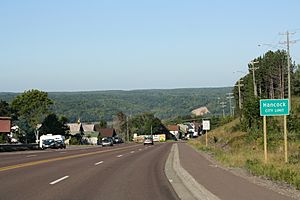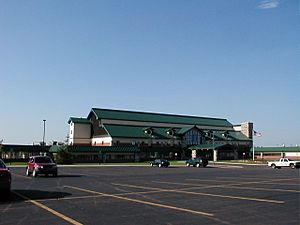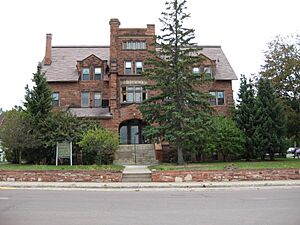Hancock, Michigan facts for kids
Quick facts for kids
Hancock, Michigan
|
|
|---|---|
| City of Hancock | |

View from Houghton looking across the Keweenaw Waterway
|
|
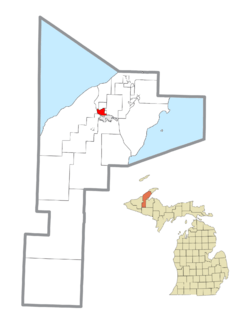
Location within Houghton County
|
|
| Country | |
| State | |
| County | Houghton |
| Founded | 1859 |
| Incorporated | 1863 (village) 1903 (city) |
| Named for | John Hancock |
| Government | |
| • Type | Council–manager |
| Area | |
| • Total | 2.78 sq mi (7.20 km2) |
| • Land | 2.78 sq mi (7.20 km2) |
| • Water | 0.00 sq mi (0.00 km2) |
| Elevation | 696 ft (212 m) |
| Population
(2020)
|
|
| • Total | 4,501 |
| • Density | 1,619.65/sq mi (625.25/km2) |
| Time zone | UTC-5 (EST (UTC-5)) |
| • Summer (DST) | UTC-4 (EDT (UTC-4)) |
| ZIP code(s) |
49930
|
| Area code(s) | 906 |
| FIPS code | 26-36300 |
| GNIS feature ID | 0627710 |
Hancock is a city in the Upper Peninsula of Michigan. In 2020, about 4,500 people lived there. The city is in Houghton County, right next to the Keweenaw Waterway. This waterway is a channel of Lake Superior that cuts across the Keweenaw Peninsula.
Hancock is across the waterway from the city of Houghton. They are connected by the Portage Lake Lift Bridge. Hancock is also part of Michigan's Copper Country region.
Many Finnish Americans consider Hancock a "cultural capital." The city has the Finnish American Heritage Center. From 1896 to 2023, it was home to Finlandia University. Some street name signs in Hancock are bilingual, showing names in both English and Finnish.
The Weather Channel often says Hancock is the third-snowiest city in the U.S.
Contents
History of Hancock

Hancock is located on land that was once home to the Ojibwa (Chippewa) people. This land was given up in a treaty in 1842. The town of Hancock started in 1847 and 1848. A group of prospectors found old Ojibwe copper mining pits on a hillside, which was later called Quincy Hill. These pits stretched for 100 feet along a copper vein. The discovery led to the creation of the Quincy Mining Company in October 1848.
The first building in what is now Hancock was a log cabin built in 1846. It was owned by Christopher Columbus (C.C.) Douglass. The Quincy Mining Company bought the land from Douglass and founded Hancock in 1859. They built an office and a mine there. The city was named after John Hancock, who signed the Declaration of Independence.
Hancock's first store opened in 1858. It also had the first post office. Samuel W. Hill planned out the Village of Hancock in 1859. The Quincy Mining Company donated land for a church in 1860.
In 1861, Hancock became its own township, separate from Portage Charter Township. The Portage Stamp Mill was also built nearby in 1861. The Keweenaw Waterway was made wider in 1860. This allowed more boats to reach Hancock and Houghton.
The Hancock Mine opened in 1859 on Quincy Hill. On March 10, 1863, the Village of Hancock was officially organized. Hervey Coke Parke was elected as the first village president. This date is seen as the founding date of Hancock.
In 1865, the first drugstore opened. The town had about 400 people, mostly miners.
The Great Fire of 1869
On April 11, 1869, a terrible fire hit Hancock. A stovepipe in a saloon exploded, and strong winds helped the fire spread quickly. It destroyed about 150 buildings, including almost all the stores and businesses, wooden bridges, and 120 homes. At that time, Hancock had no fire department. Three-fourths of the town was destroyed. It took two years to rebuild.
After the fire, the Hancock Fire Department was officially started on March 1, 1871.
Growth and Development
In 1872, the Hancock and Calumet Railroad and the Mineral Range Railroad began operating. They carried passengers and goods between Houghton, Hancock, and Calumet. In 1877, Gustave Diemal opened a jewelry and watch shop in Hancock.
In 1876, Alfred Elieser Backman became the first pastor of the Evangelical Lutheran Church of Finland in the Copper Country. Later, Juho Kustaa Nikander took over. Nikander and other pastors founded the Suomi Synod on March 25, 1890.
Suomi College was founded in September 1896 by Nikander. Its first building, called "Old Main", was finished on January 21, 1900. It was built from Jacobsville Sandstone in the Richardsonian Romanesque style. The college's publishing house, the Book Concern, was also started in 1900.
In 1898, the Quincy Smelter was built in nearby Ripley to process copper from the Quincy Mine.
On August 28, 1896, lightning struck the Finnish Evangelical Lutheran Church of Hancock. It sadly killed an assistant pastor who had just sent 50 children home because of the bad weather.
Streetcar service began in 1902, connecting Houghton, Hancock, and other towns. The Kerredge Theatre was also completed in 1902. Hancock officially became a city on March 10, 1903. Archibald J. Scott, the village president, became the city's first mayor.
In 1904, St. Joseph's Medical Center was opened. It was a five-story building made of brick and local sandstone. The Scott Hotel was finished in 1906. In 1907, the Copper Country Limited train line started, connecting Hancock to Chicago, Illinois.
In 1913, during the Copper Country Strike, Western Federation of Miners President Charles Moyer was kidnapped and beaten at the Scott Hotel. He was then sent to Chicago. This event is a famous part of local history.
Before World War I, Hancock's population dropped. Many families moved away to find work in factories or other mines.
Hancock got its second hospital, a Finnish hospital, in March 1917. The old First Congregational Church burned down in 1917, and a new one was completed in 1921.
Later Years
After the financial crash in 1929, many mines closed because copper prices were too low. The Quincy Mine closed in 1931. By 1934, many families in Houghton County needed help. The Quincy Mine reopened in 1937 but closed for good in 1946 after World War II ended.
In 1951, a new St. Joseph's Hospital facility opened. On May 29, 1959, the historic Kerredge Theater burned down. In 1963, Hancock and Houghton worked together to build a sewage plant to keep Portage Lake clean.
In 1976, the Finnish President Urho Kekkonen visited Hancock. He spoke to the local Finnish-American community at the Michigan Technological University ice arena, which was completely full. In 1990, an old Catholic church on Quincy Street was renovated and became the Finnish-American Heritage Center.
In 2023, Finlandia University, which had been open since 1896, closed its doors.
Geography and Climate
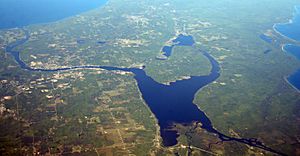
Hancock is located further north than Montreal in Canada. The city covers about 2.97 square miles (7.7 square kilometers). Most of this is land, with a small amount of water. Hancock is connected to Houghton by the Portage Lake Lift Bridge. This bridge crosses the Keweenaw Waterway, which divides the Keweenaw Peninsula in two. Both Houghton and Hancock are on bluffs about 500 feet high.
The city is bordered by the Portage Canal to the south. It also shares borders with parts of Quincy, Hancock, and Franklin Townships. Other nearby communities include Ripley and Arcadian Location.
Hancock's Climate
Hancock has a humid continental climate. This means it has long, snowy winters and a lot of lake effect snow. It is the third-snowiest city in the United States. It's also the snowiest city in the Midwestern United States and the Eastern United States. On average, Hancock gets about 211.7 inches (5.38 meters) of snow each year. In 1978–79, an amazing 390 inches (9.9 meters) of snow fell! Snow can even fall as late as early June here.
| Climate data for Hancock, Michigan (Houghton County Memorial Airport), 1981–2010 normals | |||||||||||||
|---|---|---|---|---|---|---|---|---|---|---|---|---|---|
| Month | Jan | Feb | Mar | Apr | May | Jun | Jul | Aug | Sep | Oct | Nov | Dec | Year |
| Record high °F (°C) | 50 (10) |
60 (16) |
79 (26) |
88 (31) |
95 (35) |
99 (37) |
102 (39) |
98 (37) |
95 (35) |
86 (30) |
71 (22) |
64 (18) |
102 (39) |
| Mean daily maximum °F (°C) | 22.1 (−5.5) |
24.6 (−4.1) |
33.5 (0.8) |
46.9 (8.3) |
61.0 (16.1) |
70.2 (21.2) |
75.3 (24.1) |
73.9 (23.3) |
64.6 (18.1) |
51.2 (10.7) |
37.6 (3.1) |
26.2 (−3.2) |
49.0 (9.4) |
| Daily mean °F (°C) | 15.5 (−9.2) |
16.9 (−8.4) |
25.2 (−3.8) |
38.0 (3.3) |
50.2 (10.1) |
59.3 (15.2) |
64.8 (18.2) |
63.9 (17.7) |
55.4 (13.0) |
43.4 (6.3) |
31.4 (−0.3) |
20.2 (−6.6) |
40.5 (4.7) |
| Mean daily minimum °F (°C) | 8.8 (−12.9) |
9.1 (−12.7) |
16.8 (−8.4) |
29.0 (−1.7) |
39.4 (4.1) |
48.4 (9.1) |
54.2 (12.3) |
54.0 (12.2) |
46.3 (7.9) |
35.6 (2.0) |
25.3 (−3.7) |
14.2 (−9.9) |
31.9 (−0.1) |
| Record low °F (°C) | −29 (−34) |
−30 (−34) |
−23 (−31) |
−4 (−20) |
19 (−7) |
28 (−2) |
32 (0) |
34 (1) |
24 (−4) |
12 (−11) |
−7 (−22) |
−19 (−28) |
−30 (−34) |
| Average precipitation inches (mm) | 2.58 (66) |
1.37 (35) |
1.56 (40) |
1.84 (47) |
2.50 (64) |
2.58 (66) |
2.49 (63) |
2.41 (61) |
3.45 (88) |
2.99 (76) |
2.13 (54) |
1.89 (48) |
27.79 (706) |
| Average snowfall inches (cm) | 68.8 (175) |
30.9 (78) |
19.2 (49) |
7.8 (20) |
1.0 (2.5) |
0.0 (0.0) |
0.0 (0.0) |
0.0 (0.0) |
0.2 (0.51) |
4.7 (12) |
22.2 (56) |
52.9 (134) |
207.7 (528) |
| Average precipitation days (≥ 0.01 in) | 17.4 | 12.3 | 11.5 | 10.0 | 11.1 | 10.7 | 10.8 | 9.4 | 13.5 | 15.2 | 14.9 | 15.1 | 151.9 |
| Average snowy days (≥ 0.1 in) | 23.2 | 15.5 | 10.3 | 4.9 | 0.8 | 0.0 | 0.0 | 0.0 | 0.2 | 3.5 | 12.4 | 19.7 | 90.5 |
| Source: NOAA (extremes 1887–present) | |||||||||||||
Things to See and Do
Historic Places to Visit
- The Hancock Town Hall and Fire Hall was built in 1899. It's a local landmark on Quincy Street. The building is made from Jacobsville Sandstone, a red stone found nearby.
- Old Main was the first building of Suomi College (now Finlandia University). It's a nationally important historic site. Today, it's a private place for weddings and events.
- The Pewabic House is the birthplace of Mary Chase Perry Stratton, who started the Pewabic Pottery. It's now a museum.
- You can see six old Quincy Mining Company houses on Hillside, Sampson, Roosevelt, and White Streets.
- The Scott Hotel is one of the most important hotels in the Upper Peninsula. Many famous events happened here, including the kidnapping of a union leader during the Copper Country Strike.
Interesting Places to Explore
- The Copper Country Community Arts Center on Quincy Street has three art galleries. They show art from over 170 local artists.
- The Detroit & Northern Savings and Loan Association building on Quincy Street is the city's only high-rise building.
- The Finlandia Reflection Gallery in the Jutila Center displays art from students of the University's art program.
- The Finnish-American Heritage Centre and Finnish-American National Historical Archive have the largest collection of Finnish-American history. It also has a museum, cinema, art gallery, and is home to the Finnish-American Reporter newspaper.
- The Houghton County Marina in Hancock has many boats. You can also get a great view of the Portage Lake Lift Bridge from here.
- Old Main Inn at 603 Quincy Street was built in 1900 for Suomi College. It was a dormitory, classroom, and library. After Finlandia University closed in 2023, it became a private event venue.
- Just outside Hancock, on Quincy Hill, you can find the Quincy Mine. It's part of the Keweenaw National Historical Park. You can see the 1918 Nordberg Steam Hoist, which is the world's largest steam-powered hoist engine. Visitors can also take a tour underground into the mine.
- Temple Jacob on Front Street is the only synagogue in the Copper Country.
- The main office of Vollwerth's is on Hancock Street. This company makes popular sausages and hot dogs. They also make a "Michigan Sauce" and "Baroni's Spaghetti Sauce with Meat."
Fun Activities and Recreation
- The Hancock Recreation Area is about a mile west of downtown Hancock. It's a large campground on the shores of Portage Lake.
- Mont Ripley in nearby Ripley is a popular ski area. It is Michigan's oldest ski resort.
People and Culture
Finnish-American Culture
Hancock is known as "the main spot for Finns in the United States." Many Finns moved to Hancock because the area reminded them of their home country. About 40% of the people in Hancock have Finnish ancestry. Since 1983, Hancock has had a special committee to help keep the region's Finnish heritage alive. Some street signs in Hancock are written in both English and Finnish.
Festivals and Events
Hancock hosts an annual midwinter festival called Heikinpäivä on January 19. It celebrates the feast day of Saint Henrik of Uppsala, who is the patron saint of Finland. This festival includes a traditional wife-carrying competition.
Every June, Hancock and Houghton host Bridgefest. This festival celebrates the building of the Portage Lake Lift Bridge, which connects the two communities. Also in June, there is the Keweenaw Chain Drive Festival. The Keweenaw Trail Running Festival happens every July.
City Information
Population and Demographics
| Historical population | |||
|---|---|---|---|
| Census | Pop. | %± | |
| 1880 | 1,783 | — | |
| 1890 | 1,772 | −0.6% | |
| 1900 | 4,050 | 128.6% | |
| 1910 | 8,981 | 121.8% | |
| 1920 | 7,527 | −16.2% | |
| 1930 | 5,795 | −23.0% | |
| 1940 | 5,554 | −4.2% | |
| 1950 | 5,223 | −6.0% | |
| 1960 | 5,022 | −3.8% | |
| 1970 | 4,820 | −4.0% | |
| 1980 | 5,122 | 6.3% | |
| 1990 | 4,547 | −11.2% | |
| 2000 | 4,323 | −4.9% | |
| 2010 | 4,634 | 7.2% | |
| 2020 | 4,501 | −2.9% | |
| U.S. Decennial Census | |||
In 2010, Hancock had 4,634 people living in 1,882 households. About 94.7% of the people were White. There were also smaller groups of African American, Native American, and Asian people. About 1.4% of the population was Hispanic or Latino.
The average age in the city was 34.1 years old.
Neighborhoods
- The East Hancock neighborhood has many old Victorian-style houses. These houses were once owned by mining company officials.
- Doctors' Park is a neighborhood in West Hancock. It's near the former Portage View Hospital Building.
- The Quincy Street Historic District covers the main downtown area of Hancock.
- UP Health System - Portage is a hospital located at 500 Campus Drive in Hancock.
Sports
In 2004, part of the Professional Walleye Trail Championship Tournament was held in Hancock.
Parks and Recreation
Bicycling
The Jack Stevens Rail Trail goes through Hancock. It continues 14 miles north to Calumet. This trail follows an old railroad line.
Snowmobiling
The Keweenaw Trail, also called Trail 3, is the main snowmobiling route. It connects Houghton and Hancock. It also links to other trails that lead to Lake Superior and Calumet.
Education in Hancock
Public Schools
Younger students attend Gordon Barkell Elementary School. Middle school students go to Hancock Middle School. High school students attend Hancock Central High School. The middle and high schools are now connected.
Higher Education
Hancock was home to Finlandia University (formerly Suomi College). Suomi College was founded in 1896 by the Finnish Evangelical Lutheran Church of America. Many Finns came to Hancock in the 1880s to work in copper mines and lumber. J. K. Nikander, a pastor, wanted to make sure new ministers could be trained in America. He also wanted to keep Finnish culture alive and teach English.
The first building of Suomi College, Old Main, was built in 1900 using local Jacobsville sandstone. It had dorms, classrooms, a library, and a chapel. The college grew quickly. In 1939, Nikander Hall was built. It was designed by the famous Finnish-American architect Eero Saarinen.
Parts of the Michigan Technological University campus are also in Hancock. This includes a former "underground classroom" in the Quincy Mine.
Getting Around Hancock
Highways
 US 41 goes north to Calumet and Copper Harbor. To the south, it goes to Houghton and Marquette. The Copper Country Trail National Scenic Byway is also on US 41.
US 41 goes north to Calumet and Copper Harbor. To the south, it goes to Houghton and Marquette. The Copper Country Trail National Scenic Byway is also on US 41. M-26 goes north to Hubbell, Lake Linden, and Laurium, Michigan. It follows a scenic route along Lake Superior.
M-26 goes north to Hubbell, Lake Linden, and Laurium, Michigan. It follows a scenic route along Lake Superior. M-203 connects to McLain State Park.
M-203 connects to McLain State Park.
Bus Services
Indian Trails bus lines has a stop at 125 Quincy Street. This service runs between Hancock and Milwaukee, Wisconsin.
Local Transportation
In the past, the Houghton County Traction Company ran a trolley system through Hancock. The Mineral Range Railroad also served the city.
Today, Hancock Public Transit offers a bus service. It takes riders anywhere in Hancock, Houghton, or Ripley. Checker Transport also provides service in the Hancock area.
Famous People from Hancock
- Herb Boxer, hockey player
- Anders Brännström, general of the Swedish Army
- John P. Condon, Major general, USMC
- Paul Coppo, Olympic and professional hockey player
- Jill Dickman, politician
- Ralph Heikkinen, football player
- Dwight Helminen, hockey player
- Verna Hillie, actress
- Matt Huuki, politician
- Tanner Kero, hockey player
- Ike Klingbeil, hockey player
- Michael Lahti, politician
- Robbie Laing, college basketball coach
- Joseph Linder, hockey player
- Louis Moilanen, Finnish giant
- Eddie Olson, hockey player
- Rodney Paavola, hockey player, won gold medal at 1960 Winter Olympics
- Bruce Riutta, hockey player
- Rent Romus, saxophonist, bandleader, composer, and record producer
- John D. Ryan, industrialist and copper mining tycoon
- Peter Shaw, actor
- Mary Chase Perry Stratton, ceramic artist and co-founder of Pewabic Pottery
Sister City
Hancock is a sister city with Porvoo, Finland.
See also
 In Spanish: Hancock (Míchigan) para niños
In Spanish: Hancock (Míchigan) para niños






